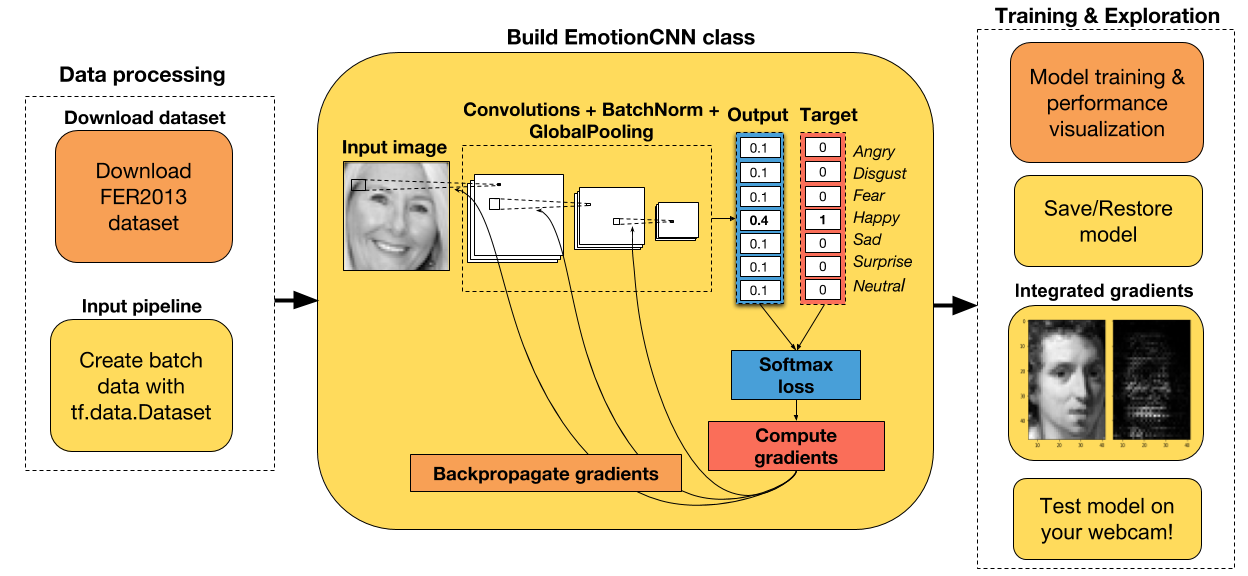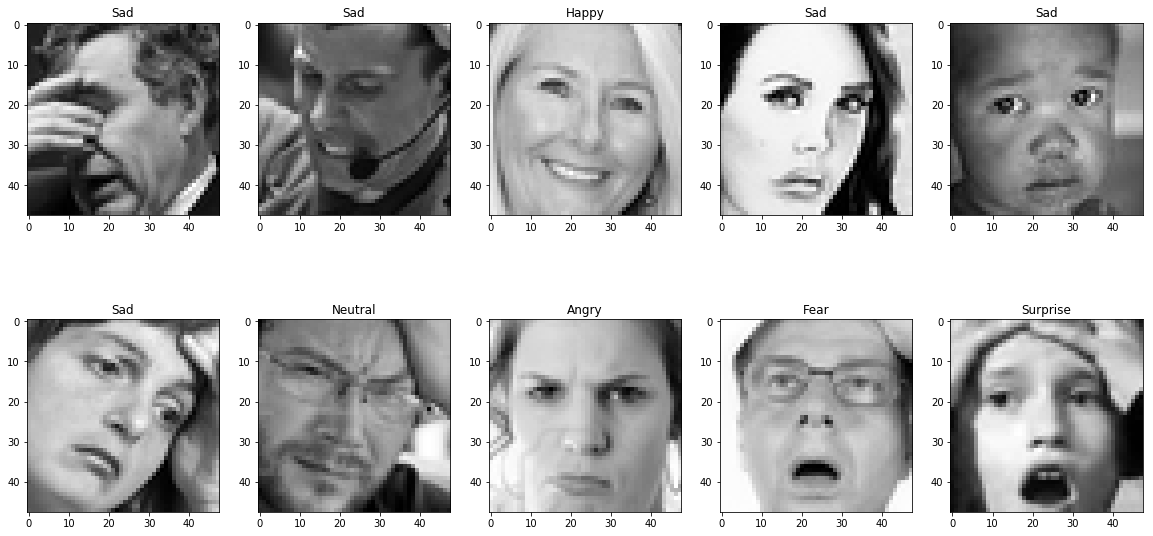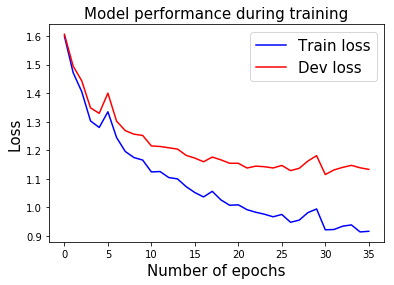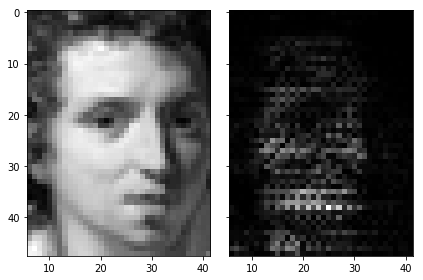# 七、使用 TensorFlow Eager 构建用于情感识别的卷积神经网络(CNN)
对于深度学习,我最喜欢的部分之一就是我可以解决一些问题,其中我自己可以测试神经网络。 到目前为止,我建立的最有趣的神经网络是用于情感识别的 CNN。 我已经设法通过网络传递我的网络摄像头视频,并实时预测了我的情绪(使用 GTX-1070)。 相当容易上瘾!
因此,如果你想将工作与乐趣结合起来,那么你一定要仔细阅读本教程。 另外,这是熟悉 Eager API 的好方法!
教程步骤

+ 下载并处理 Kaggle 上提供的 FER2013 数据集。
+ 整个数据集上的探索性数据分析。
+ 将数据集拆分为训练和开发数据集。
+ 标准化图像。
+ 使用`tf.data.Dataset` API 遍历训练和开发数据集。
+ 在 Eager 模式下为 CNN 创建一个类。
+ 能够保存模型或从先前的检查点恢复。
+ 创建一个损失函数,一个优化器和一个梯度计算函数。
+ 用梯度下降训练模型。
+ 从头开始或者从预训练模型开始。
+ 在训练期间可视化表现并计算准确率。
+ 使用集成梯度可视化样本图像上的 CNN 归属。
+ 使用 OpenCV 和 Haar 级联算法在新图像上测试 CNN。
## 导入有用的库
```py
# 导入 TensorFlow 和 TensorFlow Eager
import tensorflow as tf
import tensorflow.contrib.eager as tfe
# 导入函数来生成玩具分类问题
from sklearn.datasets import make_moons
import numpy as np
# 导入绘图库
import matplotlib.pyplot as plt
%matplotlib inline
# 开启 Eager 模式。一旦开启不能撤销!只执行一次。
tfe.enable_eager_execution()
```
## 下载数据集
为了训练我们的 CNN,我们将使用 Kaggle 上提供的 FER2013 数据集。 你必须在他们的平台上自己下载数据集,遗憾的是我无法公开分享数据。 尽管如此,数据集只有 96.4 MB,因此你应该能够立即下载它。 你可以在[这里](https://www.kaggle.com/c/challenges-in-representation-learning-facial-expression-recognition-challenge/data)下载。
下载完数据后,将其解压缩并放入名为`datasets`的文件夹中,这样你就不必对下面的代码进行任何修改。
好的,让我们开始探索性数据分析!
## 探索性数据分析
在构建任何机器学习模型之前,建议对数据集进行探索性数据分析。 这使你有机会发现数据集中的任何缺陷,如类之间的强烈不平衡,低质量图像等。
我发现机器学习项目中出现的大多数错误,都是由于数据处理不正确造成的。 如果你在发现模型没有用后才开始调查数据集,那么找到这些错误会更加困难。
所以,我给你的建议是:在构建任何模型之前总是分析数据。
```py
# 读取输入数据。假设已经解压了数据集,并放入名为 data 的文件夹中。
path_data = 'datasets/fer2013/fer2013.csv'
data = pd.read_csv(path_data)
print('Number of samples in the dataset: ', data.shape[0])
# Number of samples in the dataset: 35887
# 查看前五行
data.head(5)
```
| | emotion | pixels | Usage |
| --- | --- | --- | --- |
| 0 | 0 | 70 80 82 72 58 58 60 63 54 58 60 48 89 115 121... | Training |
| 1 | 0 | 151 150 147 155 148 133 111 140 170 174 182 15... | Training |
| 2 | 2 | 231 212 156 164 174 138 161 173 182 200 106 38... | Training |
| 3 | 4 | 24 32 36 30 32 23 19 20 30 41 21 22 32 34 21 1... | Training |
| 4 | 6 | 4 0 0 0 0 0 0 0 0 0 0 0 3 15 23 28 48 50 58 84... | Training |
```py
# 获取每个表情的含义
emotion_cat = {0:'Angry', 1:'Disgust', 2:'Fear', 3:'Happy', 4:'Sad', 5:'Surprise', 6:'Neutral'}
# 查看标签分布(检查不平衡)
target_counts = data['emotion'].value_counts().reset_index(drop=False)
target_counts.columns = ['emotion', 'number_samples']
target_counts['emotion'] = target_counts['emotion'].map(emotion_cat)
target_counts
```
| | emotion | number_samples |
| --- | --- | --- |
| 0 | Happy | 8989 |
| 1 | Neutral | 6198 |
| 2 | Sad | 6077 |
| 3 | Fear | 5121 |
| 4 | Angry | 4953 |
| 5 | Surprise | 4002 |
| 6 | Disgust | 547 |
如你所见,数据集非常不平衡。 特别是对于情绪`Disgust`。 这将使这个类的训练更加困难,因为网络将有更少的机会来学习这种表情的表示。
在我们训练网络之后,稍后我们会看到这是否会严重影响我们网络的训练。
我们来看看一些图片!
图像当前表示为整数的字符串,每个整数表示一个像素的强度。 我们将处理字符串。将其表示为整数列表。
```py
# 将图像从字符串换换位整数列表
data['pixels'] = data['pixels'].apply(lambda x: [int(pixel) for pixel in x.split()])
# 修改这里的种子来查看其它图像
random_seed = 2
# 随机选择十个图像
data_sample = data.sample(10, random_state=random_seed)
# 为图像创建子图
f, axarr = plt.subplots(2, 5, figsize=(20, 10))
# 绘制图像
i, j = 0, 0
for idx, row in data_sample.iterrows():
img = np.array(row['pixels']).reshape(48,48)
axarr[i,j].imshow(img, cmap='gray')
axarr[i,j].set_title(emotion_cat[row['emotion']])
if j==4:
i += 1
j = 0
else:
j += 1
```

## 将数据集拆分为训练/开发,并按最大值标准化图像
```py
data_traindata_tra = data[data['Usage']=='Training']
size_train = data_train.shape[0]
print('Number samples in the training dataset: ', size_train)
data_dev = data[data['Usage']!='Training']
size_dev = data_dev.shape[0]
print('Number samples in the development dataset: ', size_dev)
'''
Number samples in the training dataset: 28709
Number samples in the development dataset: 7178
'''
# 获取训练输入和标签
X_train, y_train = data_train['pixels'].tolist(), data_train['emotion'].as_matrix()
# 将图像形状修改为 4D(样本数,宽,高,通道数)
X_train = np.array(X_train, dtype='float32').reshape(-1,48,48,1)
# 使用最大值标准化图像(最大像素密度为 255)
X_train = X_train/255.0
# 获取开发输入和标签
X_dev, y_dev = data_dev['pixels'].tolist(), data_dev['emotion'].as_matrix()
# 将图像形状修改为 4D(样本数,宽,高,通道数)
X_dev = np.array(X_dev, dtype='float32').reshape(-1,48,48,1)
# 使用最大值标准化图像
X_dev = X_dev/255.0
```
## 使用`tf.data.Dataset` API
为了准备我们的数据集用作 CNN 的输入,我们将使用`tf.data.Dataset` API,将我们刚刚创建的 numpy 数组转换为 TF 张量。 由于此数据集比以前教程中的数据集大得多,因此我们实际上必须将数据批量提供给模型。
通常,为了提高计算效率,你可以选择与内存一样大的批量。 但是,根据我的经验,如果我在训练期间使用较小的批量,我会在测试数据上获得更好的结果。 随意调整批量大小,看看你是否得到了与我相同的结论。
```py
# 随意调整批量大小
# 通常较小的批量大小在测试集上获取更好的结果
batch_size = 64
training_data = tf.data.Dataset.from_tensor_slices((X_train, y_train[:,None])).batch(batch_size)
eval_data = tf.data.Dataset.from_tensor_slices((X_dev, y_dev[:,None])).batch(batch_size)
```
## 在 Eager 模式下创建 CNN 模型
CNN 架构在下面的单元格中创建。 如你所见,`EmotionRecognitionCNN`类继承自`tf.keras.Model`类,因为我们想要跟踪包含任何可训练参数的层(例如卷积的权重,批量标准化层的平均值)。 这使我们易于保存这些变量,然后在我们想要继续训练网络时将其恢复。
这个 CNN 的原始架构可以在这里找到(使用 keras 构建)。 我认为如果你开始使用比 ResNet 更简单的架构,那将非常有用。 对于这个网络规模,它的效果非常好。
你可以使用它,添加更多的层,增加层的数量,过滤器等。看看你是否可以获得更好的结果。
有一点可以肯定的是,dropout 越高,网络效果越好。
```py
class EmotionRecognitionCNN(tf.keras.Model):
def __init__(self, num_classes, device='cpu:0', checkpoint_directory=None):
''' 定义在正向传播期间使用的参数化层,你要在它上面运行计算的设备,以及检查点目录。
Args:
num_classes: the number of labels in the network.
device: string, 'cpu:n' or 'gpu:n' (n can vary). Default, 'cpu:0'.
checkpoint_directory: the directory where you would like to save or
restore a model.
'''
super(EmotionRecognitionCNN, self).__init__()
# 初始化层
self.conv1 = tf.layers.Conv2D(16, 5, padding='same', activation=None)
self.batch1 = tf.layers.BatchNormalization()
self.conv2 = tf.layers.Conv2D(16, 5, 2, padding='same', activation=None)
self.batch2 = tf.layers.BatchNormalization()
self.conv3 = tf.layers.Conv2D(32, 5, padding='same', activation=None)
self.batch3 = tf.layers.BatchNormalization()
self.conv4 = tf.layers.Conv2D(32, 5, 2, padding='same', activation=None)
self.batch4 = tf.layers.BatchNormalization()
self.conv5 = tf.layers.Conv2D(64, 3, padding='same', activation=None)
self.batch5 = tf.layers.BatchNormalization()
self.conv6 = tf.layers.Conv2D(64, 3, 2, padding='same', activation=None)
self.batch6 = tf.layers.BatchNormalization()
self.conv7 = tf.layers.Conv2D(64, 1, padding='same', activation=None)
self.batch7 = tf.layers.BatchNormalization()
self.conv8 = tf.layers.Conv2D(128, 3, 2, padding='same', activation=None)
self.batch8 = tf.keras.layers.BatchNormalization()
self.conv9 = tf.layers.Conv2D(256, 1, padding='same', activation=None)
self.batch9 = tf.keras.layers.BatchNormalization()
self.conv10 = tf.layers.Conv2D(128, 3, 2, padding='same', activation=None)
self.conv11 = tf.layers.Conv2D(256, 1, padding='same', activation=None)
self.batch11 = tf.layers.BatchNormalization()
self.conv12 = tf.layers.Conv2D(num_classes, 3, 2, padding='same', activation=None)
# 定义设备
self.device = device
# 定义检查点目录
self.checkpoint_directory = checkpoint_directory
def predict(self, images, training):
""" 根据输入样本预测每个类的概率。
Args:
images: 4D tensor. Either an image or a batch of images.
training: Boolean. Either the network is predicting in
training mode or not.
"""
x = self.conv1(images)
x = self.batch1(x, training=training)
x = self.conv2(x)
x = self.batch2(x, training=training)
x = tf.nn.relu(x)
x = tf.layers.dropout(x, rate=0.4, training=training)
x = self.conv3(x)
x = self.batch3(x, training=training)
x = self.conv4(x)
x = self.batch4(x, training=training)
x = tf.nn.relu(x)
x = tf.layers.dropout(x, rate=0.3, training=training)
x = self.conv5(x)
x = self.batch5(x, training=training)
x = self.conv6(x)
x = self.batch6(x, training=training)
x = tf.nn.relu(x)
x = tf.layers.dropout(x, rate=0.3, training=training)
x = self.conv7(x)
x = self.batch7(x, training=training)
x = self.conv8(x)
x = self.batch8(x, training=training)
x = tf.nn.relu(x)
x = tf.layers.dropout(x, rate=0.3, training=training)
x = self.conv9(x)
x = self.batch9(x, training=training)
x = self.conv10(x)
x = self.conv11(x)
x = self.batch11(x, training=training)
x = self.conv12(x)
return tf.layers.flatten(x)
def loss_fn(self, images, target, training):
""" 定义训练期间使用的损失函数。
"""
preds = self.predict(images, training)
loss = tf.losses.sparse_softmax_cross_entropy(labels=target, logits=preds)
return loss
def grads_fn(self, images, target, training):
""" 在每个正向步骤中,
动态计算损失值对模型参数的梯度
"""
with tfe.GradientTape() as tape:
loss = self.loss_fn(images, target, training)
return tape.gradient(loss, self.variables)
def restore_model(self):
""" 用于恢复已训练模型的函数
"""
with tf.device(self.device):
# Run the model once to initialize variables
dummy_input = tf.constant(tf.zeros((1,48,48,1)))
dummy_pred = self.predict(dummy_input, training=False)
# Restore the variables of the model
saver = tfe.Saver(self.variables)
saver.restore(tf.train.latest_checkpoint
(self.checkpoint_directory))
def save_model(self, global_step=0):
""" 用于保存已训练模型的函数
"""
tfe.Saver(self.variables).save(self.checkpoint_directory,
global_step=global_step)
def compute_accuracy(self, input_data):
""" 在输入数据上计算准确率
"""
with tf.device(self.device):
acc = tfe.metrics.Accuracy()
for images, targets in tfe.Iterator(input_data):
# Predict the probability of each class
logits = self.predict(images, training=False)
# Select the class with the highest probability
preds = tf.argmax(logits, axis=1)
# Compute the accuracy
acc(tf.reshape(targets, [-1,]), preds)
return acc
def fit(self, training_data, eval_data, optimizer, num_epochs=500,
early_stopping_rounds=10, verbose=10, train_from_scratch=False):
""" 使用所选优化器和所需数量的迭代来训练模型。 你可以从头开始训练或加载最后训练的模型。 提前停止用于降低过拟合网络的风险。
Args:
training_data: the data you would like to train the model on.
Must be in the tf.data.Dataset format.
eval_data: the data you would like to evaluate the model on.
Must be in the tf.data.Dataset format.
optimizer: the optimizer used during training.
num_epochs: the maximum number of iterations you would like to
train the model.
early_stopping_rounds: stop training if the loss on the eval
dataset does not decrease after n epochs.
verbose: int. Specify how often to print the loss value of the network.
train_from_scratch: boolean. Whether to initialize variables of the
the last trained model or initialize them
randomly.
"""
if train_from_scratch==False:
self.restore_model()
# 初始化最佳损失。 此变量存储评估数据集上的最低损失。
best_loss = 999
# 初始化类来更新训练和评估的平均损失
train_loss = tfe.metrics.Mean('train_loss')
eval_loss = tfe.metrics.Mean('eval_loss')
# 初始化字典来存储损失的历史记录
self.history = {}
self.history['train_loss'] = []
self.history['eval_loss'] = []
# 开始训练
with tf.device(self.device):
for i in range(num_epochs):
# 使用梯度下降来训练
for images, target in tfe.Iterator(training_data):
grads = self.grads_fn(images, target, True)
optimizer.apply_gradients(zip(grads, self.variables))
# 计算一个迭代后的训练数据的损失
for images, target in tfe.Iterator(training_data):
loss = self.loss_fn(images, target, False)
train_loss(loss)
self.history['train_loss'].append(train_loss.result().numpy())
# 重置指标
train_loss.init_variables()
# 计算一个迭代后的评估数据的损失
for images, target in tfe.Iterator(eval_data):
loss = self.loss_fn(images, target, False)
eval_loss(loss)
self.history['eval_loss'].append(eval_loss.result().numpy())
# 重置指标
eval_loss.init_variables()
# 打印训练和评估损失
if (i==0) | ((i+1)%verbose==0):
print('Train loss at epoch %d: ' %(i+1), self.history['train_loss'][-1])
print('Eval loss at epoch %d: ' %(i+1), self.history['eval_loss'][-1])
# 为提前停止而检查
if self.history['eval_loss'][-1]<best_loss:
best_loss = self.history['eval_loss'][-1]
count = early_stopping_rounds
else:
count -= 1
if count==0:
break
```
## 使用梯度下降和提前停止来训练模型
我在训练网络 35 个迭代后保存了权重。 你可以在更多的几个迭代中恢复和微调它们。 如果你的计算机上没有 GPU,那么进一步调整模型将比从头开始训练模型容易得多。
如果在`n`个时期之后开发数据集上的损失没有减少,则可以使用提前停止来停止训练网络(可以使用变量`early_stopping_rounds`设置`n`的数量)。
```py
# 指定你打算保存/恢复已训练变量的路径
checkpoint_directory = 'models_checkpoints/EmotionCNN/'
# 如果可用,则使用 GPU
device = 'gpu:0' if tfe.num_gpus()>0 else 'cpu:0'
# 定义优化器
optimizer = tf.train.AdamOptimizer()
# 实例化模型。这不会实例化变量
model = EmotionRecognitionCNN(num_classes=7, device=device,
checkpoint_directory=checkpoint_directory)
# 训练模型
model.fit(training_data, eval_data, optimizer, num_epochs=500,
early_stopping_rounds=5, verbose=10, train_from_scratch=False)
'''
Train loss at epoch 1: 1.5994938561539342
Eval loss at epoch 1: 1.6061641948413006
Train loss at epoch 10: 1.1655063030448947
Eval loss at epoch 10: 1.2517835698296538
Train loss at epoch 20: 1.007327914901725
Eval loss at epoch 20: 1.1543473274306912
Train loss at epoch 30: 0.9942544895184863
Eval loss at epoch 30: 1.1808805191411382
'''
# 保存已训练模型
model.save_model()
```
## 在训练期间展示表现
```py
pltplt..plotplot((rangerange((lenlen((modelmodel..historyhistory[['train_loss''train_l ])), model.history['train_loss'],
color='b', label='Train loss');
plt.plot(range(len(model.history['eval_loss'])), model.history['eval_loss'],
color='r', label='Dev loss');
plt.title('Model performance during training', fontsize=15)
plt.xlabel('Number of epochs', fontsize=15);
plt.ylabel('Loss', fontsize=15);
plt.legend(fontsize=15);
```

## 计算准确率
```py
train_acc = model.compute_accuracy(training_data)
eval_acc = model.compute_accuracy(eval_data)
print('Train accuracy: ', train_acc.result().numpy())
print('Eval accuracy: ', eval_acc.result().numpy())
'''
Train accuracy: 0.6615347103695706
Eval accuracy: 0.5728615213151296
'''
```
## 使用集成梯度展示神经网络归属
所以现在我们已经训练了我们的 CNN 模型,让我们看看我们是否可以使用集成梯度来理解它的推理。本文详细解释了这种方法,称为深度网络的 Axiomatic 归属。
通常,你首先尝试理解,模型的预测是直接计算输出类对图像的导数。这可以为你提供提示,图像的哪个部分激活网络。但是,这种技术对图像伪影很敏感。
为了避免这种缺陷,我们将使用集成梯度来计算特定图像的网络归属。该技术简单地采用原始图像,将像素强度缩放到不同的度数(从`1/m`到`m`,其中`m`是步数)并且计算对每个缩放图像的梯度。为了获得该归属,对所有缩放图像的梯度进行平均并与原始图像相乘。
以下是使用 TensorFlow Eager 实现此操作的示例:
```py
def get_prob_class(X, idx_class):
""" 获取所选图像的 softmax 概率
Args:
X: 4D tensor image.
Returns:
prob_class: the probability of the selected class.
"""
logits = model.predict(X, False)
prob_class = logits[0, idx_class]
return prob_class
def integrated_gradients(X, m=200):
""" 为一个图像样本计算集成梯度
Args:
X: 4D tensor of the image sample.
m: number of steps, more steps leads to a better approximation.
Returns:
g: integrated gradients.
"""
perc = (np.arange(1,m+1)/m).reshape(m,1,1,1)
perc = tf.constant(perc, dtype=tf.float32)
idx_class = tf.argmax(model.predict(X, False), axis=1).numpy()[0]
X_tiled = tf.tile(X, [m,1,1,1])
X_scaled = tf.multiply(X_tiled, perc)
grad_fn = tfe.gradients_function(get_prob_class, params=[0])
g = grad_fn(X_scaled, idx_class)
g = tf.reduce_mean(g, axis=[1])
g = tf.multiply(X, g)
return g, idx_class
def visualize_attributions(X, g, idx_class):
""" 使用集成渐变绘制原始图像以及 CNN 归属。
Args:
X: 4D tensor image.
g: integrated gradients.
idx_class: the index of the predicted label.
"""
img_attributions = X*tf.abs(g)
f, (ax1, ax2) = plt.subplots(1, 2, sharey=True)
ax1.imshow(X[0,:,:,0], cmap='gray')
ax1.set_title('Predicted emotion: %s' %emotion_cat[idx_class], fontsize=15)
ax2.imshow(img_attributions[0,:,:,0], cmap='gray')
ax2.set_title('Integrated gradients', fontsize=15)
plt.tight_layout()
with tf.device(device):
idx_img = 1000 # modify here to change the image
X = tf.constant(X_train[idx_img,:].reshape(1,48,48,1))
g, idx_class = integrated_gradients(X, m=200)
visualize_attributions(X, g, idx_class)
```

集成梯度图像的较亮部分对预测标签的影响最大。
## 网络摄像头测试
最后,你可以在任何新的图像或视频集上测试 CNN 的性能。 在下面的单元格中,我将向你展示如何使用网络摄像头捕获图像帧并对其进行预测。
为此,你必须安装`opencv-python`库。 你可以通过在终端输入这些来轻松完成此操作:
```
pip install opencv-python
```
正如你在笔记本开头看到的那样,FER2013 数据集中的图像已经裁剪了面部。 为了裁剪新图像/视频中的人脸,我们将使用 OpenCV 库中预先训练的 Haar-Cascade 算法。
那么,让我们开始吧!
如果要在实时网络摄像头镜头上运行模型,请使用:
```py
cap = cv2.VideoCapture(0)
```
如果你有想要测试的预先录制的视频,可以使用:
```py
cap = cv2.VideoCapture(path_video)
```
自己随意尝试网络! 我保证这会很有趣。
```py
# 导入OpenCV
import cv2
# 创建字符来将文本添加到图像
font = cv2.FONT_HERSHEY_SIMPLEX
# 导入与训练的 Haar 级联算法
face_cascade = cv2.CascadeClassifier(cv2.data.haarcascades + "haarcascade_frontalface_default.xml")
```
网络摄像头捕获的代码受到[本教程](https://docs.opencv.org/3.0-beta/doc/py_tutorials/py_gui/py_video_display/py_video_display.html)的启发。
```py
# Open video capture
cap = cv2.VideoCapture(0)
# Uncomment if you want to save the video along with its predictions
# fourcc = cv2.VideoWriter_fourcc(*'mp4v')
# out = cv2.VideoWriter('test_cnn.mp4', fourcc, 20.0, (720,480))
while(True):
# 逐帧捕获
ret, frame = cap.read()
# 从 RGB 帧转换为灰度
gray = cv2.cvtColor(frame, cv2.COLOR_BGR2GRAY)
# 检测帧中的所有人脸
faces = face_cascade.detectMultiScale(gray, 1.3, 5)
# 遍历发现的每个人脸
for (x,y,w,h) in faces:
# 剪裁灰度帧中的人脸
face_gray = gray[y:y+h, x:x+w]
# 将图像大小改为 48x48 像素
face_res = cv2.resize(face_gray, (48,48))
face_res = face_res.reshape(1,48,48,1)
# 按最大值标准化图像
face_norm = face_res/255.0
# 模型上的正向传播
with tf.device(device):
X = tf.constant(face_norm)
X = tf.cast(X, tf.float32)
logits = model.predict(X, False)
probs = tf.nn.softmax(logits)
ordered_classes = np.argsort(probs[0])[::-1]
ordered_probs = np.sort(probs[0])[::-1]
k = 0
# 为每个预测绘制帧上的概率
for cl, prob in zip(ordered_classes, ordered_probs):
# 添加矩形,宽度与其概率成比例
cv2.rectangle(frame, (20,100+k),(20+int(prob*100),130+k),(170,145,82),-1)
# 向绘制的矩形添加表情标签
cv2.putText(frame,emotion_cat[cl],(20,120+k),font,1,(0,0,0),1,cv2.LINE_AA)
k += 40
# 如果你希望将视频写到磁盘,就取消注释
#out.write(frame)
# 展示所得帧
cv2.imshow('frame',frame)
if cv2.waitKey(1) & 0xFF == ord('q'):
break
# 一切都完成后,解除捕获
cap.release()
cv2.destroyAllWindows()
```
- TensorFlow 1.x 深度学习秘籍
- 零、前言
- 一、TensorFlow 简介
- 二、回归
- 三、神经网络:感知器
- 四、卷积神经网络
- 五、高级卷积神经网络
- 六、循环神经网络
- 七、无监督学习
- 八、自编码器
- 九、强化学习
- 十、移动计算
- 十一、生成模型和 CapsNet
- 十二、分布式 TensorFlow 和云深度学习
- 十三、AutoML 和学习如何学习(元学习)
- 十四、TensorFlow 处理单元
- 使用 TensorFlow 构建机器学习项目中文版
- 一、探索和转换数据
- 二、聚类
- 三、线性回归
- 四、逻辑回归
- 五、简单的前馈神经网络
- 六、卷积神经网络
- 七、循环神经网络和 LSTM
- 八、深度神经网络
- 九、大规模运行模型 -- GPU 和服务
- 十、库安装和其他提示
- TensorFlow 深度学习中文第二版
- 一、人工神经网络
- 二、TensorFlow v1.6 的新功能是什么?
- 三、实现前馈神经网络
- 四、CNN 实战
- 五、使用 TensorFlow 实现自编码器
- 六、RNN 和梯度消失或爆炸问题
- 七、TensorFlow GPU 配置
- 八、TFLearn
- 九、使用协同过滤的电影推荐
- 十、OpenAI Gym
- TensorFlow 深度学习实战指南中文版
- 一、入门
- 二、深度神经网络
- 三、卷积神经网络
- 四、循环神经网络介绍
- 五、总结
- 精通 TensorFlow 1.x
- 一、TensorFlow 101
- 二、TensorFlow 的高级库
- 三、Keras 101
- 四、TensorFlow 中的经典机器学习
- 五、TensorFlow 和 Keras 中的神经网络和 MLP
- 六、TensorFlow 和 Keras 中的 RNN
- 七、TensorFlow 和 Keras 中的用于时间序列数据的 RNN
- 八、TensorFlow 和 Keras 中的用于文本数据的 RNN
- 九、TensorFlow 和 Keras 中的 CNN
- 十、TensorFlow 和 Keras 中的自编码器
- 十一、TF 服务:生产中的 TensorFlow 模型
- 十二、迁移学习和预训练模型
- 十三、深度强化学习
- 十四、生成对抗网络
- 十五、TensorFlow 集群的分布式模型
- 十六、移动和嵌入式平台上的 TensorFlow 模型
- 十七、R 中的 TensorFlow 和 Keras
- 十八、调试 TensorFlow 模型
- 十九、张量处理单元
- TensorFlow 机器学习秘籍中文第二版
- 一、TensorFlow 入门
- 二、TensorFlow 的方式
- 三、线性回归
- 四、支持向量机
- 五、最近邻方法
- 六、神经网络
- 七、自然语言处理
- 八、卷积神经网络
- 九、循环神经网络
- 十、将 TensorFlow 投入生产
- 十一、更多 TensorFlow
- 与 TensorFlow 的初次接触
- 前言
- 1. TensorFlow 基础知识
- 2. TensorFlow 中的线性回归
- 3. TensorFlow 中的聚类
- 4. TensorFlow 中的单层神经网络
- 5. TensorFlow 中的多层神经网络
- 6. 并行
- 后记
- TensorFlow 学习指南
- 一、基础
- 二、线性模型
- 三、学习
- 四、分布式
- TensorFlow Rager 教程
- 一、如何使用 TensorFlow Eager 构建简单的神经网络
- 二、在 Eager 模式中使用指标
- 三、如何保存和恢复训练模型
- 四、文本序列到 TFRecords
- 五、如何将原始图片数据转换为 TFRecords
- 六、如何使用 TensorFlow Eager 从 TFRecords 批量读取数据
- 七、使用 TensorFlow Eager 构建用于情感识别的卷积神经网络(CNN)
- 八、用于 TensorFlow Eager 序列分类的动态循坏神经网络
- 九、用于 TensorFlow Eager 时间序列回归的递归神经网络
- TensorFlow 高效编程
- 图嵌入综述:问题,技术与应用
- 一、引言
- 三、图嵌入的问题设定
- 四、图嵌入技术
- 基于边重构的优化问题
- 应用
- 基于深度学习的推荐系统:综述和新视角
- 引言
- 基于深度学习的推荐:最先进的技术
- 基于卷积神经网络的推荐
- 关于卷积神经网络我们理解了什么
- 第1章概论
- 第2章多层网络
- 2.1.4生成对抗网络
- 2.2.1最近ConvNets演变中的关键架构
- 2.2.2走向ConvNet不变性
- 2.3时空卷积网络
- 第3章了解ConvNets构建块
- 3.2整改
- 3.3规范化
- 3.4汇集
- 第四章现状
- 4.2打开问题
- 参考
- 机器学习超级复习笔记
- Python 迁移学习实用指南
- 零、前言
- 一、机器学习基础
- 二、深度学习基础
- 三、了解深度学习架构
- 四、迁移学习基础
- 五、释放迁移学习的力量
- 六、图像识别与分类
- 七、文本文件分类
- 八、音频事件识别与分类
- 九、DeepDream
- 十、自动图像字幕生成器
- 十一、图像着色
- 面向计算机视觉的深度学习
- 零、前言
- 一、入门
- 二、图像分类
- 三、图像检索
- 四、对象检测
- 五、语义分割
- 六、相似性学习
- 七、图像字幕
- 八、生成模型
- 九、视频分类
- 十、部署
- 深度学习快速参考
- 零、前言
- 一、深度学习的基础
- 二、使用深度学习解决回归问题
- 三、使用 TensorBoard 监控网络训练
- 四、使用深度学习解决二分类问题
- 五、使用 Keras 解决多分类问题
- 六、超参数优化
- 七、从头开始训练 CNN
- 八、将预训练的 CNN 用于迁移学习
- 九、从头开始训练 RNN
- 十、使用词嵌入从头开始训练 LSTM
- 十一、训练 Seq2Seq 模型
- 十二、深度强化学习
- 十三、生成对抗网络
- TensorFlow 2.0 快速入门指南
- 零、前言
- 第 1 部分:TensorFlow 2.00 Alpha 简介
- 一、TensorFlow 2 简介
- 二、Keras:TensorFlow 2 的高级 API
- 三、TensorFlow 2 和 ANN 技术
- 第 2 部分:TensorFlow 2.00 Alpha 中的监督和无监督学习
- 四、TensorFlow 2 和监督机器学习
- 五、TensorFlow 2 和无监督学习
- 第 3 部分:TensorFlow 2.00 Alpha 的神经网络应用
- 六、使用 TensorFlow 2 识别图像
- 七、TensorFlow 2 和神经风格迁移
- 八、TensorFlow 2 和循环神经网络
- 九、TensorFlow 估计器和 TensorFlow HUB
- 十、从 tf1.12 转换为 tf2
- TensorFlow 入门
- 零、前言
- 一、TensorFlow 基本概念
- 二、TensorFlow 数学运算
- 三、机器学习入门
- 四、神经网络简介
- 五、深度学习
- 六、TensorFlow GPU 编程和服务
- TensorFlow 卷积神经网络实用指南
- 零、前言
- 一、TensorFlow 的设置和介绍
- 二、深度学习和卷积神经网络
- 三、TensorFlow 中的图像分类
- 四、目标检测与分割
- 五、VGG,Inception,ResNet 和 MobileNets
- 六、自编码器,变分自编码器和生成对抗网络
- 七、迁移学习
- 八、机器学习最佳实践和故障排除
- 九、大规模训练
- 十、参考文献
